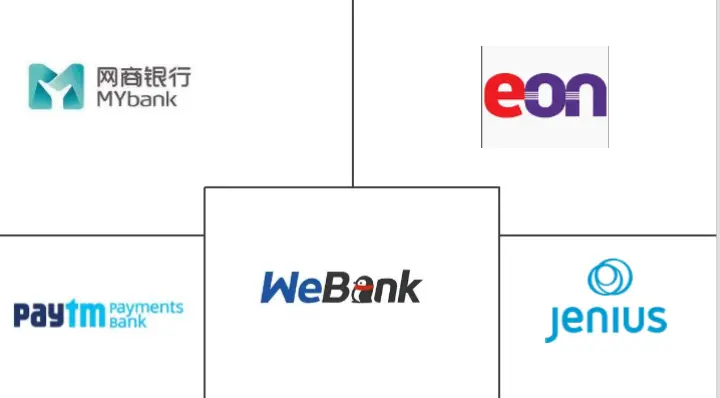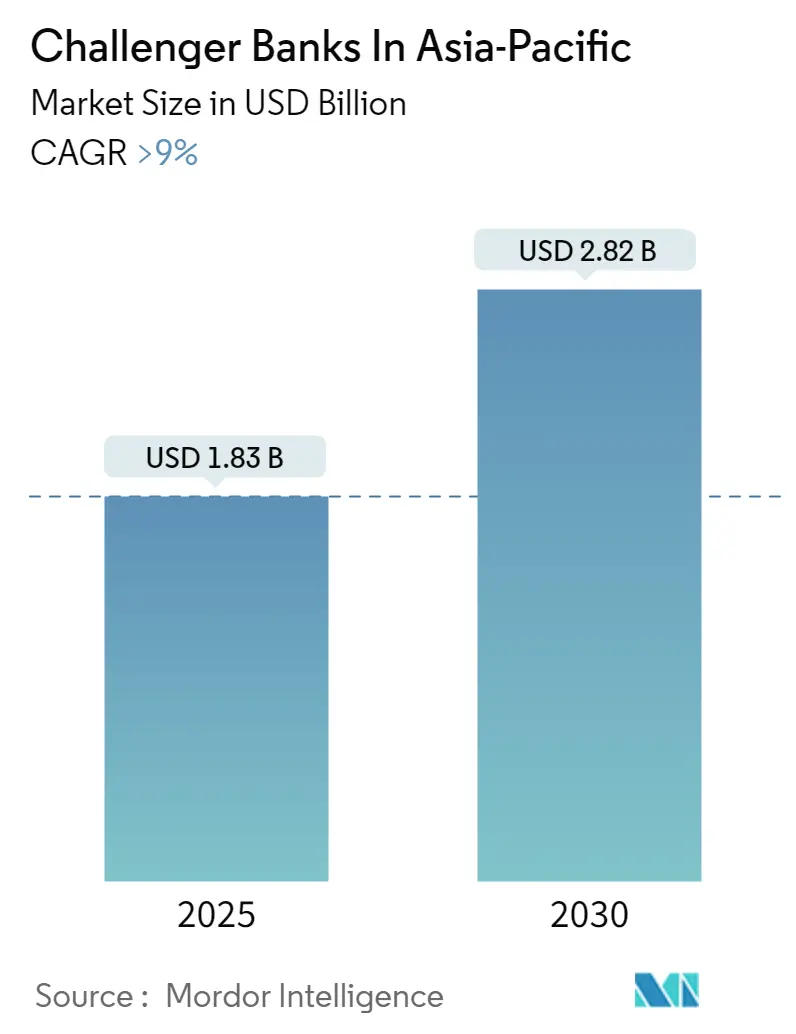
Asia-Pacific Challenger Banks Market Analysis by Mordor Intelligence
The Challenger Banks In Asia-Pacific Market size is estimated at USD 1.83 billion in 2025, and is expected to reach USD 2.82 billion by 2030, at a CAGR of greater than 9% during the forecast period (2025-2030).
Even though the onset of the pandemic enhanced the need for rapid tech-led transformation for the banks and financial services players, they are still being used by many people. Digital banks, also known as neobanks, challenger banks, or virtual banks, all have in common are they often started with no physical branches and leveraged technology to differentiate their offerings in the banking sphere.The virtual banks are helping a lot of people in the Asia - Pacific region to have a smooth banking experience without visiting the bank. Asia’s digital banking scene has seen rapid growth in recent years and is set to continue its growth in the months to come.
63% of banking customers in Asia-Pacific (APAC) are likely to use digital banking services offered by neobanks and challenger banks by 2025, highlighting the urgency for banks to innovate. Also many commercial places such as restauarants are now looking towards Challengers Banks as they are flexible enough, without having a need to visit any physical bank. More than 35 neobanks or challengers across APAC are built on agile innovative best practices — way ahead of incumbents in terms of flexibility, self-service capabilities, customer needs, and personalization. Consequently, with the emergence of new players and further digital disruption in the industry, 38% of traditional banks’ revenues are at risk by 2025.
Additionally, a recent report has revealed that Asian Pacific countries are becoming increasingly interested in the digital banking space, with India being home to twenty percent of the global number of digital challenger banks. The report has noted that the Indian Subcontinent has witnessed the emergence of a three-pronged attack in the space, consisting of banks' own challengers such as Bank 811 and Bank Digibank, as well as new challengers such as Network, Fi Money and FamPay, as well as Open and Jupiter, as well as ecosystem players Paytm, Razorpay.
Asia-Pacific Challenger Banks Market Trends and Insights
Raise in Mobile Penetration and High Unbanked Adults in the Region
The emergence of emerging markets in Asia Pacific region offers a significant potential for challenger banks, due to a number of factors, including a large unbanked population, high mobile penetration, and a rapidly expanding middle class. An estimated 250 million adults in the Southeast Asian countries are unbanked; however, only 27% of these adults have bank accounts. The majority of Asia Pacific region have a mobile penetration rate of more than 100%, surpassing the penetration rate of the United States, and comparable to that of Europe. In Indonesia, only 48% of adults aged 15 years and above have bank accounts, while in Malaysia, over 2 million adults are unbanked. In Vietnam, only 30% of those aged 15 years and older have bank accounts, and in the Philippines, only 32% of the population aged 15 and over have bank accounts. India had a smartphone penetration rate of 56% which is estimated to go up to 96% by 2040. Even though 81% of the country’s population has access to at least one bank account, the financial inclusion levels are yet to improve. Though 38.2 million beneficiaries were added to the Pradhan Mantri Jan Dhan Yojana (PMJDY), only 8.9 million were issued RuPay cards.
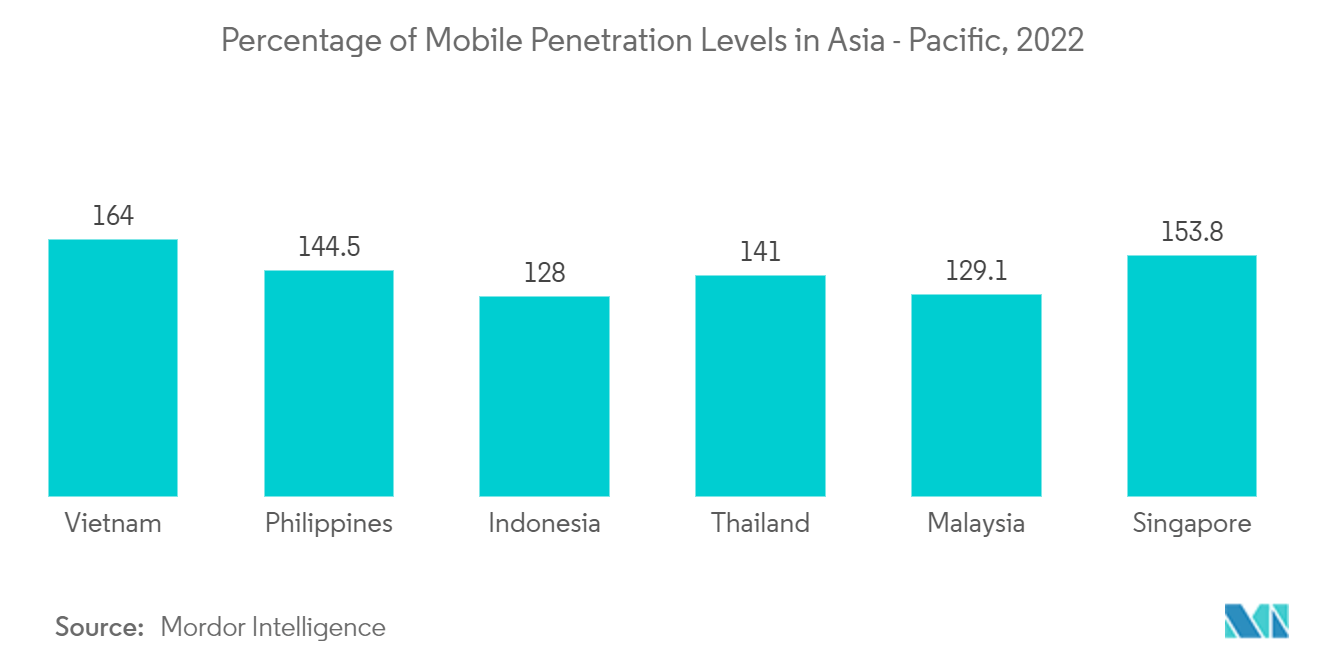
Financing Activity on Rise into Challengers in Asia-Pacific
In recent years, there has been a surge in equity financing or mergers and acquisitions (M&A) in the market, as challenger banks have become increasingly attractive to investors and have been able to demonstrate to them that their business model and valuations appear to be realistic. A prime example of this is Kakao, an internet-only Korean bank, which was launched by Kakao Communications, a communications company. Within 24 hours, Kakao Bank had 300,000 new customers, 930 million USD in deposits in a week, and more than 6,500 million accounts in one year, surpassing the annual average of some incumbents and challenger banks. Moreover, Paytm Payments Bank was established in India as a subsidiary of Paytm, a leading mobile payment company. The bank provides a wide range of financial services, including savings, current, and fixed deposits, along with debit cards and wallets. Additionally, payments can be made in real-time through India's Unified Payments Interface (UPI), FASTag, and other payment instruments. It is one of the most prominent digital banks in India, with a customer base of over 330 million, including 65 million current accounts and 5 million savings accounts. Similarly, numerous challengers appear to have built up the trust of investors to invest in their firms, and the infographic below provides an overview of the financing activities of the challengers in recent years.
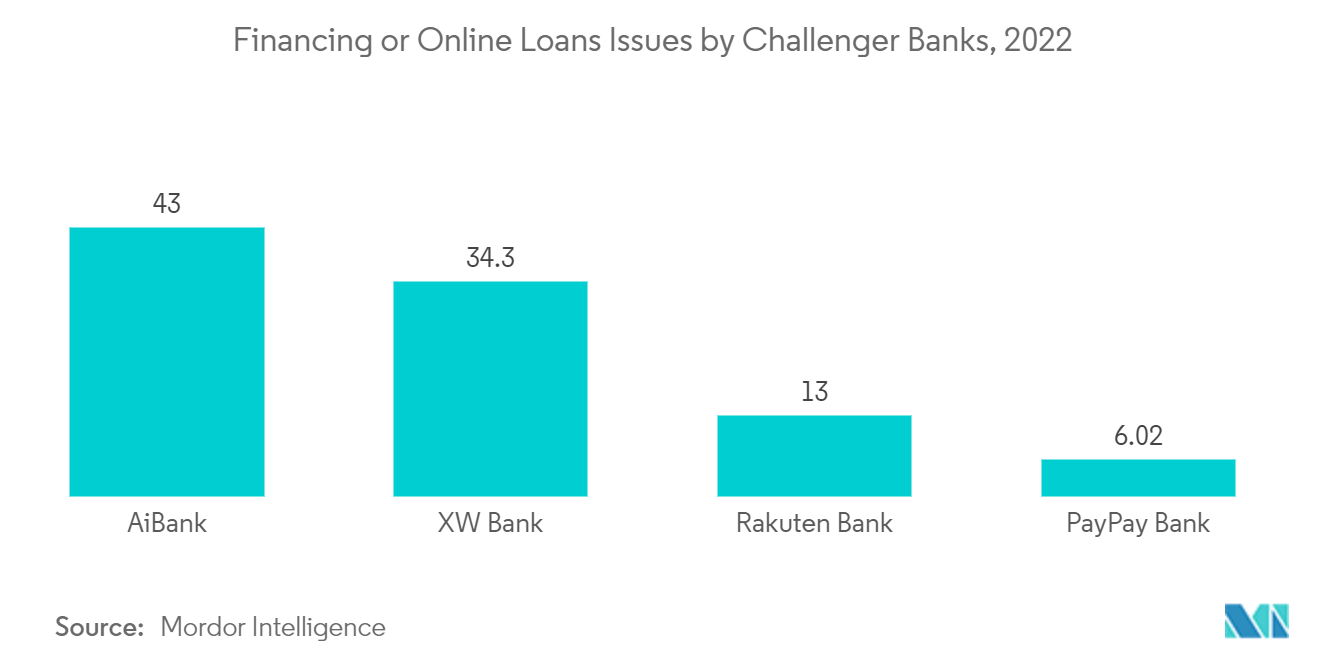
Competitive Landscape
The report includes an overview of challenger banks operating across the region. Currently, some of the major players dominating the market are WeBank, MY Bank, EON Bank PH, Paytm Payments Bank, and Jenius Bank, among others. The market is moderately fragmented with the major players occupying approximately 42 % of the market share but the other players also occupied a signifacnt percentage of the market share. Technology adoption in the sector, government initiatives toward changes in challenger banks regulations, merger and acquistion by the companies, and many other factors can drive the market during the forecast period.
Asia-Pacific Challenger Banks Industry Leaders
WeBank
MY Bank
EON Bank PH
Paytm Payments Bank
Jenius Bank
- *Disclaimer: Major Players sorted in no particular order
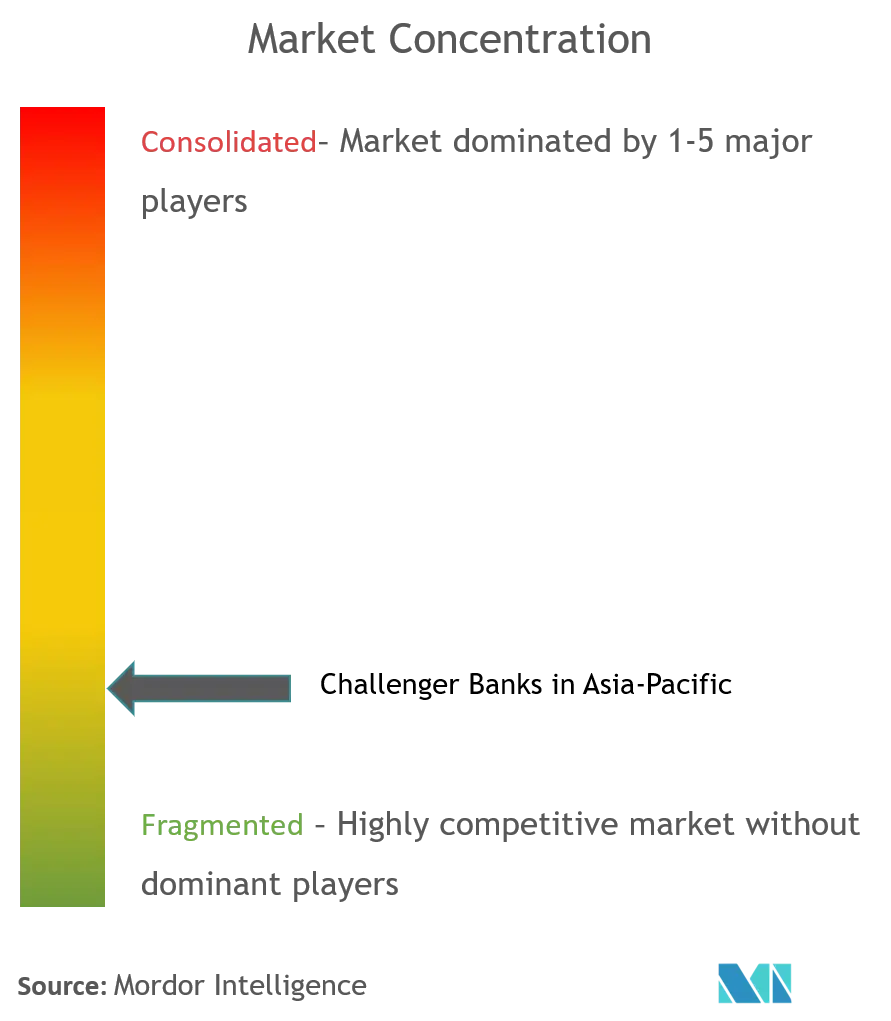
Recent Industry Developments
- In October 2023, Paytm launched the industry’s first alternate ID-based guest checkout solution for merchants. Tokenisation masks the 16-digit debit or credit card number with a unique token that is specific to one’s card to prevent misuse and theft from merchant websites.
- In July 2023, Paytm announced the launch of two innovative payment devices that are 4G enabled — Paytm Pocket Soundbox and Paytm Music Soundbox. The first-of-its-kind portable device, Paytm Pocket Soundbox, can fit in your pocket and is as small as a debit card, and empowers merchants who are always on the move with instant audio payment alerts.
Asia-Pacific Challenger Banks Market Report Scope
The challenger banks are set to provide a different banking experience to the customers, different from the traditional banks. A complete background analysis of the Challenger Banks Market, market overview, market size estimation for key segments, emerging trends in the market, market dynamics, and key company profiles are covered in the report. The Challenger Banks Market in Asia-Pacific is segmentedby services offered, end-user type, and by country. By services offered, the market is segmented as Payments,Savings Products, Current Account, Consumers Credits, Loans and Others. By end-user type, the market is segmented as Business Segment and Personal Segment. By Country, the market is segmented as China, South Korea, Australia, Hong Kong, India, Indonesia, Philippines, Malaysia, Singapore and Rest of Asia-Pacific. The market size and forecasts are provided in terms of value (USD) for all the above segments.
| Payments |
| Savings Products |
| Current Account |
| Consumer Credit |
| Loans |
| Others |
| Business Segment |
| Personal Segment |
| China |
| South Korea |
| Australia |
| Hong Kong |
| India |
| Indonesia |
| Philippines |
| Malaysia |
| Singapore |
| Rest of Asia-Pacific |
| By Service Type | Payments |
| Savings Products | |
| Current Account | |
| Consumer Credit | |
| Loans | |
| Others | |
| By End-User Type | Business Segment |
| Personal Segment | |
| By Country | China |
| South Korea | |
| Australia | |
| Hong Kong | |
| India | |
| Indonesia | |
| Philippines | |
| Malaysia | |
| Singapore | |
| Rest of Asia-Pacific |
Key Questions Answered in the Report
How big is the Challenger Banks In Asia-Pacific Market?
The Challenger Banks In Asia-Pacific Market size is expected to reach USD 1.83 billion in 2025 and grow at a CAGR of greater than 9% to reach USD 2.82 billion by 2030.
What is the current Challenger Banks In Asia-Pacific Market size?
In 2025, the Challenger Banks In Asia-Pacific Market size is expected to reach USD 1.83 billion.
Who are the key players in Challenger Banks In Asia-Pacific Market?
WeBank, MY Bank, EON Bank PH, Paytm Payments Bank and Jenius Bank are the major companies operating in the Challenger Banks In Asia-Pacific Market.
What years does this Challenger Banks In Asia-Pacific Market cover, and what was the market size in 2024?
In 2024, the Challenger Banks In Asia-Pacific Market size was estimated at USD 1.67 billion. The report covers the Challenger Banks In Asia-Pacific Market historical market size for years: 2020, 2021, 2022, 2023 and 2024. The report also forecasts the Challenger Banks In Asia-Pacific Market size for years: 2025, 2026, 2027, 2028, 2029 and 2030.
Page last updated on:
Asia-Pacific Challenger Banks Market Report
Statistics for the 2025 Challenger Banks In Asia-Pacific market share, size and revenue growth rate, created by Mordor Intelligence™ Industry Reports. Challenger Banks In Asia-Pacific analysis includes a market forecast outlook for 2025 to 2030 and historical overview. Get a sample of this industry analysis as a free report PDF download.
